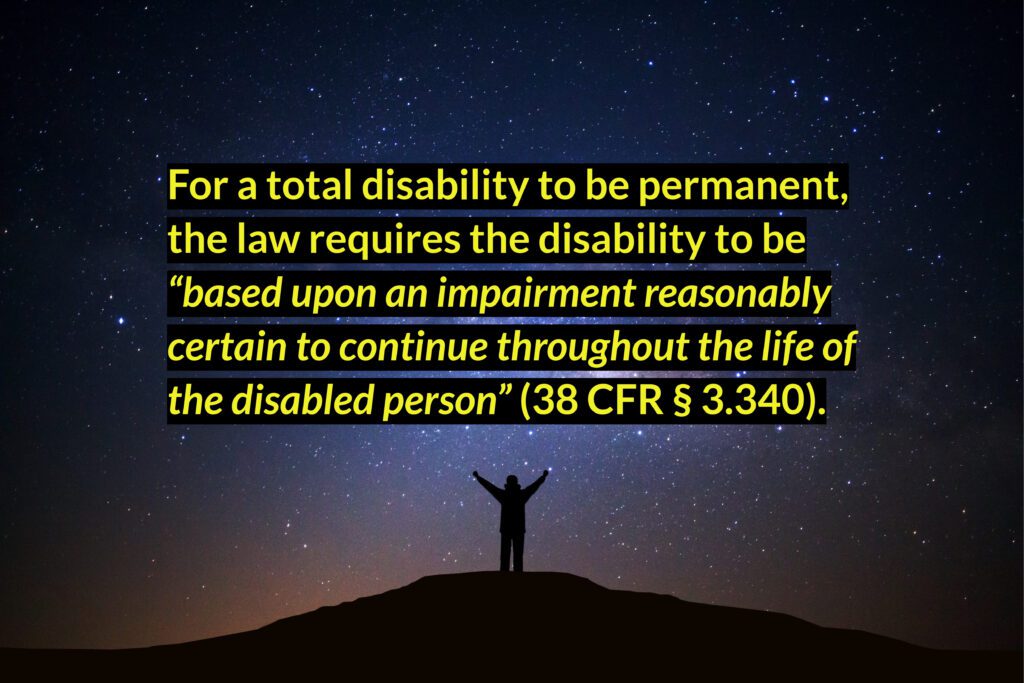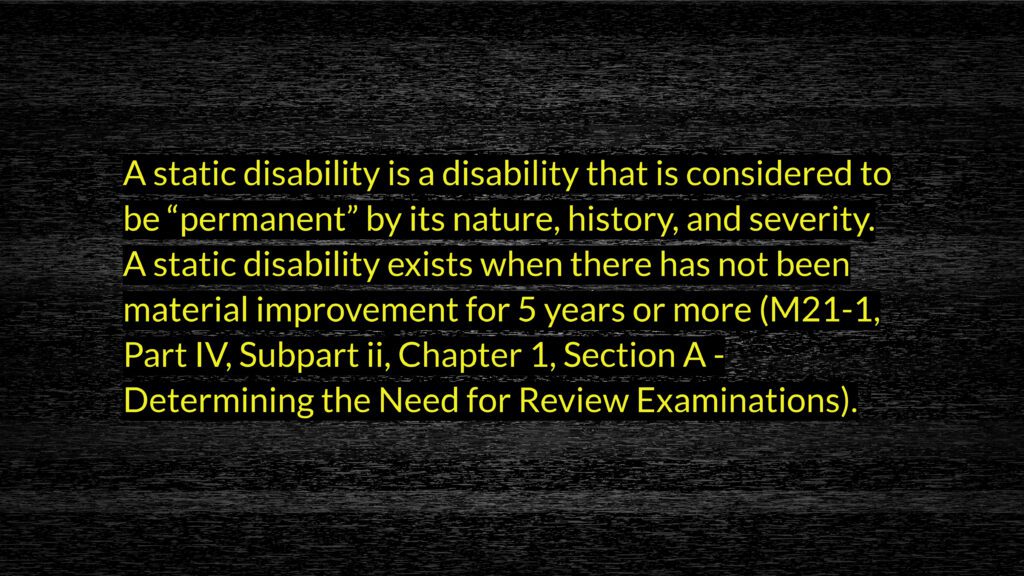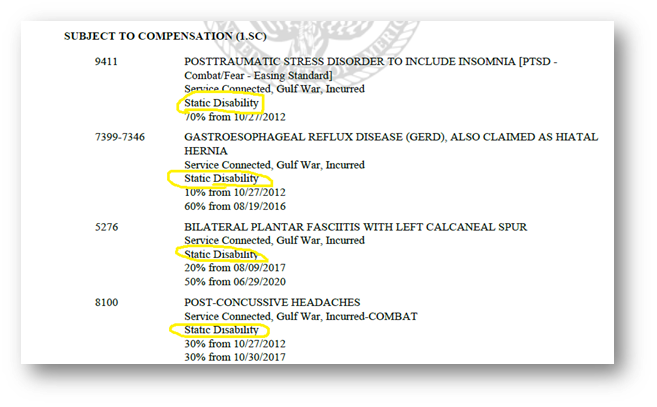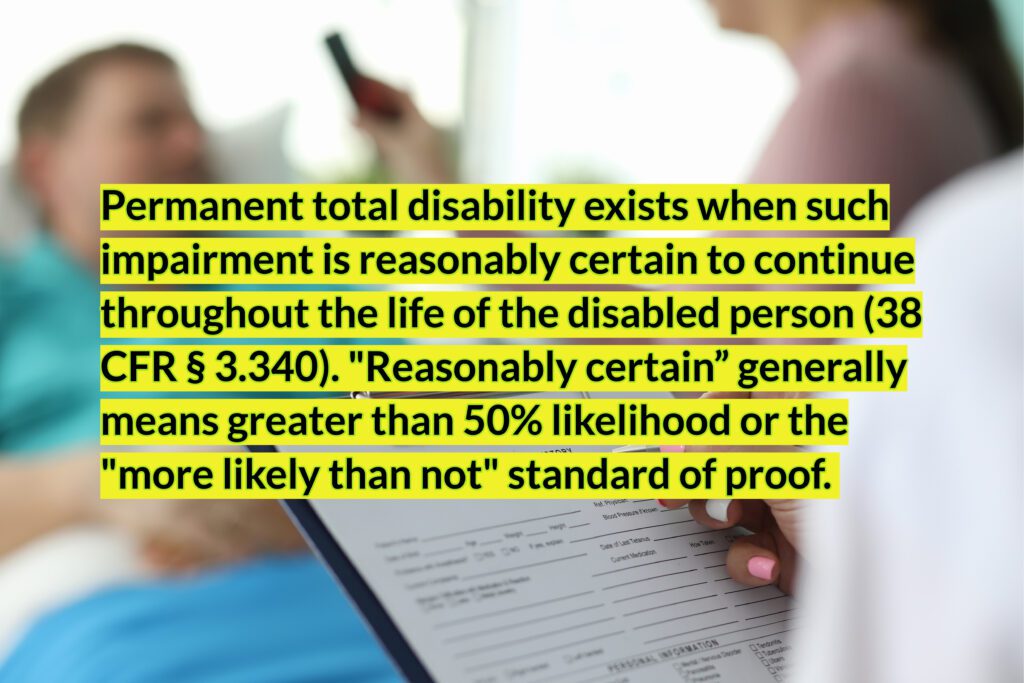Looking for Expert-Level VA Claim Answers?📱Call Us Now! 737-295-2226
In this post, we will explain our simple 4-step process to write a powerful VA permanent disability letter.
This is especially important for veterans with a 100 percent VA disability rating who are attempting to upgrade their rating to “Permanent and Total Disability ” status.
Except for the 7 types of protected VA disability ratings, the VA does periodically review a veteran’s VA disabilities to see if a condition has worsened, stayed the same, or improved.
There are two critical concepts VA Raters must consider when determining P&T status:
- A VA reevaluation request (or VA rating reduction) must consider whether a current disability condition considered “Static” and/or “Permanent.”
- A VA rating reduction request must consider whether the medical evidence shows there has been “material improvement” over time.
To protect yourself from a possible VA rating reduction, and to possibly upgrade an existing rating to permanent and total disability, it can be helpful to write a VA permanent disability letter.
Okay, let’s jump into some P&T eligibility requirements as well as our tips for writing a strong VA permanent and total disability letter.
- VA Permanent and Total Disability Eligibility
- VA Permanent Disability Letter Part #1: Provide a Brief Introduction of Who You Are and Why You’re Seeking 100% P&T Status
- VA Permanent and Total Disability Letter Part #2: Explain Why and How Your Disability Conditions Should Be Considered Static, Permanent, and Total
- VA P&T Letter Example Part #3: List Why and How Your Disability Conditions Will Not Show Material Improvement Over Time
- 100 Percent VA P&T Letter Part #4: Ask the VA For 100% Permanent and Total VA Disability Status Along with an Effective Date
- VA Permanent Disability Letter Example
- About the Author
Are you STUCK, FRUSTRATED and UNDERRATED?
You are not alone! We are Veterans helping Veterans!
Become an Elite Member and work with our Veteran Coaches to get the rating you deserve!
VA Permanent and Total Disability Eligibility

To be eligible for permanent and total disability status, the law requires veterans to have a “total disability permanent in nature.”
Veterans meet the requirements for total disability when they have a 100 percent disability rating due to service connected disabilities or if their service connected disabilities make them unemployable (unable to maintain substantially gainful employment).
For a total disability to be permanent, the law requires the disability to be “based upon an impairment reasonably certain to continue throughout the life of the disabled person” (38 CFR § 3.340).
While the VA sometimes adds P&T status automatically for veterans who qualify, sometimes it doesn’t.
Veterans can meet the requirements for P&T status independently by writing a strong disability letter and seeking the assistance of his/her treating physician or other private medical professionals.
VA Permanent Disability Letter Part #1: Provide a Brief Introduction of Who You Are and Why You’re Seeking 100% P&T Status

In Part #1, you’ll want to provide the VA Rater with background details, to include your military service history, list of service connected disabilities, current combined VA rating, and why you’re seeking permanent and total disability from the VA.
Here’s an example of how to write this section:
My name is John B. Doe, and I served in the United States Army as an Infantryman from 2002-2012. I deployed to Iraq in 2005 and Afghanistan and 2008. My military service, to include multiple deployments, led to numerous disability conditions that I struggle with every single day of my life. I’m currently service connected for Combat PTSD (70%), Sleep Apnea (50%), Headaches (30%), GERD (20%), Shoulder Condition (20%), Lumbar Strain (10%), and Tinnitus (10%). My overall combined VA rating is 100% scheduler; however, I don’t currently have P&T status. I’m seeking 100% permanent and total disability status from the VA because my conditions meet the definitions of Static, Permanent, and Total, and are unlikely to show ‘Material Improvement’ as I get older.
Deserve a HIGHER VA Rating? WE CAN HELP.
Join our premier education-based membership program, VA Claims Insider Elite, connect with an expert-level Veteran Coach (VC) within minutes, and finally get the rating you deserve. Click the button below to get started.
VA Permanent and Total Disability Letter Part #2: Explain Why and How Your Disability Conditions Should Be Considered Static, Permanent, and Total

In Part #2, you’ll want to explain WHY and HOW your disability conditions meet the definition of Static, Permanent, and Total.
It’s helpful to include the exact definitions and legal authority when writing your VA permanent disability letter.
- A static disability is a disability that is considered to be “permanent” by its nature, history, and severity. A static disability exists when there has not been material improvement for 5 years or more (M21-1, Part IV, Subpart ii, Chapter 1, Section A – Determining the Need for Review Examinations).
- A permanent disability exists when it is reasonably certain, based upon medical evidence, that the level of impairment will continue for the rest of the veteran’s life (38 CFR § 3.340).
- Total disability exists when there is present any impairment of mind or body which is sufficient to render it impossible for the average person to follow a substantially gainful occupation (38 CFR § 3.340).
- Permanent total disability exists when such impairment is reasonably certain to continue throughout the life of the disabled person (38 CFR § 3.340). “Reasonably Certain” generally means greater than 50 percent likelihood or the “more likely than not” standard of proof.
Pro Tip: You can ask your Accredited VSO to download your VA Disability Code Sheet from the Veteran Benefits Management System (VBMS). You can also get a copy of your Code Sheet by requesting your VA C File. The Code Sheet will show each disability and whether it’s determined to be “static” in nature. A “static” disability that’s been in-place for 5 years or more is not subject to re-evaluation or a rating reduction.

Here’s an example of how to write this section:
In accordance with ‘M21-1, Part IV, Subpart ii, Chapter 1, Section A – Determining the Need for Review Examinations,’ my disability conditions meet the definition of ‘static’ and are ‘permanent’ by their nature, history, and severity. In addition, a static disability exists when there has not been material improvement over 5 years, which is applicable to my claim. My service connected disabilities were rated in 2013 and have been static since that time. Also, I meet the definition of a ‘Total’ disability as I have a 100% combined VA rating that has significantly affected my ability to find substantially gainful employment, although I am blessed to be working now. Finally, in accordance with 38 CFR § 3.340, I meet the definition of ‘Permanent Total Disability,’ because the impairment is reasonably certain to continue throughout my life.
VA P&T Letter Example Part #3: List Why and How Your Disability Conditions Will Not Show Material Improvement Over Time

In Part #3, it’s important to explain to the VA Rater WHY and HOW your disability conditions are unlikely to show material improvement over time.
It’s important to have MEDICAL EVIDENCE from a medical professional demonstrating this fact, rather than just citing your own opinion as a lay person.
We recommend having your treating physical or private medical professional write a letter explaining that your disabilities are medically unlikely to improve over time.
This is part of how you show the VA that you meet the definition of a Permanent and Total Disability by law.
Here’s an example of how to write this section:
Please see the attached Code Sheet and letter written by Doctor Ozz where she explains medically why and how my 7 service connected conditions are unlikely to show material improvement over time: Combat PTSD (70%), Sleep Apnea (50%), Headaches (30%), GERD (20%), Shoulder Condition (20%), Lumbar Strain (10%), and Tinnitus (10%). My service connected disabilities have been service connected and rated at the same level (static and permanent) since 2013.
100 Percent VA P&T Letter Part #4: Ask the VA For 100% Permanent and Total VA Disability Status Along with an Effective Date

In Part #4, you’ll want to ask the VA Rater to grant you 100 percent permanent and total disability status along with an appropriate effective date.
Unless you have disabilities in appeal status, your effective date can be no longer than one year from your notice of intent to file.
You should also add the line:
“I CERTIFY THAT the statements on this letter are true and correct to the best of my knowledge and belief.”
Sign and date the letter and list where to find your most recent contact information.
Here’s an example of how to write this section:
In summary and for the reasons cited herein, please grant me permanent and total disability status as of my most recent notice of intent to file date. I CERTIFY THAT the statements on this letter are true and correct to the best of my knowledge and belief. If you need anything further, please contact me at the home address, phone number, or email address listed in my VA.gov profile.
Respectfully,
John B. Doe
USA Disabled Veteran (2002-2012)
VA Permanent Disability Letter Example
My name is John B. Doe, and I served in the United States Army as an Infantryman from 2002-2012. I deployed to Iraq in 2005 and Afghanistan and 2008. My military service, to include multiple deployments, led to numerous disability conditions that I struggle with every single day of my life. I’m currently service connected for Combat PTSD (70%), Sleep Apnea (50%), Headaches (30%), GERD (20%), Shoulder Condition (20%), Lumbar Strain (10%), and Tinnitus (10%). My overall combined VA rating is 100% scheduler; however, I don’t currently have P&T status. I’m seeking 100% permanent and total disability status from the VA because my conditions meet the definitions of Static, Permanent, and Total, and are unlikely to show ‘Material Improvement’ as I get older.
In accordance with ‘M21-1, Part IV, Subpart ii, Chapter 1, Section A – Determining the Need for Review Examinations,’ my disability conditions meet the definition of ‘static’ and are ‘permanent’ by their nature, history, and severity. In addition, a static disability exists when there has not been material improvement over 5 years, which is applicable to my claim. My service connected disabilities were rated in 2013 and have been static since that time. Also, I meet the definition of a ‘Total’ disability as I have a 100% combined VA rating that has significantly affected my ability to find substantially gainful employment, although I am blessed to be working now. Finally, in accordance with 38 CFR § 3.340, I meet the definition of ‘Permanent Total Disability,’ because the impairment is reasonably certain to continue throughout my life.
Please see the attached Code Sheet and letter written by Doctor Ozz where she explains medically why and how my 7 service connected conditions are unlikely to show material improvement over time: Combat PTSD (70%), Sleep Apnea (50%), Headaches (30%), GERD (20%), Shoulder Condition (20%), Lumbar Strain (10%), and Tinnitus (10%). My service connected disabilities have been service connected and rated at the same level (static and permanent) since 2013.
In summary and for the reasons cited herein, please grant me permanent and total disability status as of my most recent notice of intent to file date. I CERTIFY THAT the statements on this letter are true and correct to the best of my knowledge and belief. If you need anything further, please contact me at the home address, phone number, or email address listed in my VA.gov profile.
Respectfully,
John B. Doe
USA Disabled Veteran (2002-2012)
About the Author

Brian Reese
Brian Reese is a world-renowned VA disability benefits expert and the #1 bestselling author of VA Claim Secrets and You Deserve It. Motivated by his own frustration with the VA claim process, Brian founded VA Claims Insider to help disabled veterans secure their VA disability compensation faster, regardless of their past struggles with the VA. Since 2013, he has positively impacted the lives of over 10 million military, veterans, and their families.
A former active-duty Air Force officer, Brian has extensive experience leading diverse teams in challenging international environments, including a combat tour in Afghanistan in 2011 supporting Operation ENDURING FREEDOM.
Brian is a Distinguished Graduate of Management from the United States Air Force Academy and earned his MBA from Oklahoma State University’s Spears School of Business, where he was a National Honor Scholar, ranking in the top 1% of his class.



